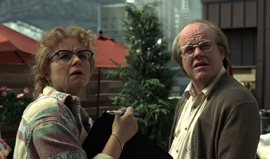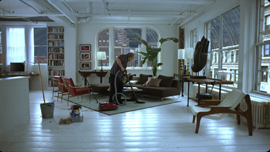Unpack This Heart: Synecdoche, New York (Review)
The following ideas may not enhance a viewing of or even appear relevant to the film. Taken together, the film appears to be not so much the struggles of a man who fears a meaningless death, but an examination of the startlingly fruitful work of a mind, working to create a society within itself.
Somewhere along the way for screenwriter and director Charley Kaufman, Shakespeare's couplet “the play’s the thing/wherein I’ll catch the conscience of the King” must have been on his mind.1 Hamlet's famous schematic may be the best log line possible for a film which, like its central character, is desperate to reflect as much as possible in a finite form. Be it the film, or the life of the main character, played with a startlingly transparency and articulation by Philip Seymour Hoffman, or most obviously the stage play that becomes his life’s work, that is nothing less than the goal.
Like other scripts by the same author, a substantial and conventional acts early in the film fall away like so many rocket stages as the payload achieves some intended orbit, however erratically. Similarly to Adaptation, once this translation is achieved the viewer is largely without assistant in understanding. This ambiguousness is unavoidable, and that’s what makes the film watchable. It certainly would not qualify as enjoyable and at times it turns cold and uneven, nearly repellant. There are a number of discreet ways of interpreting the strange events of the film, which, depending on one’s intepretation, takes place over forty or more years of a life in nearly continual desperation and existential stress.
The existential mile markers are easy to find. Caden has his gums surveyed like so many collectable stamps and suffers the meeting of head and scalpel that is oral surgery. He is obsessed with the quality and color of his bowel movements—it’s easy to see this, along with dramaturgy as the only products of his life, a means of measure. He suffers mysterious gastrointestinal problems which further force Caden to view himself as a flawed system of pipes. The whole thing underlines the apparently fragility of the human experience and brings into question free will and art in the face of decay. How to take arms against this? Caden enjoys the abstract relaxation in cleaning his house. But all of this is mere primer.
The heart of the film is the stage play he mounts after accepting, at least for a time, his fragility, the loss of his wife and daughter, and the idea that nothing can be rationally planned or even enjoyed in the face of inevitable annihilation. Again, the film is open to interpretation. I take this idea, in conjunction with the obvious fantastic scope of his play reproduction—the number of players, costs, time, staging, and location are all dreamlike in their scope and mutability—as indicators that everything the proceeds following his abandonment is a view not of Caden in the real world, but of of his own mind’s efforts to organize itself.
In this sense the bulk of the film is a diorama, to be viewed metaphorically, for Caden’s mind and it’s indomitable will to interpret the world and organize itself in that world. The end of the film especially validates this analysis. The following is exclusively a discussion of this metaphor and the film’s closing events.
A Mind Makes A Mind
The construction of the locations of Caden’s life within the massive Brooklyn warehouse can be seen as the construction of memory. We can take this further by seeing the many players as agents, each one bringing one or two iotas of meaning into focus.
Eckhart Tolle succinctly links 2 the Cartesian mentalism of “I think therefore I am” with the materialist nausea of Sartre through the recognition of the discrete relationship between the “I am” and the “I think”. Caden embodies this idea fully, both in his inital warehouse production, and the prismatic, looping referential versions contained therein, like so many chambers in the nautilus. This approach can also be seen though a cognitive lens. Marvin Minsky’s Society of Mind posits the mind as a sum of mechanical mindlessness:
I’ll call “Society of Mind” this scheme in which each mind is made of many smaller processes. These we’ll call agents. Each mental agent by itself can only do some simple thing that needs no mind or thought at all. Yet when we join these agents in societies—in certain very special ways—this leads to intelligence. 3
When “directing” he works to reproduce events shortly after they occur. Once satisfied with the actors portrayal—blocking, conflict, motivation, language—he has the elevated stage walled over, placing Caden at a safe distance, insulated from what we assume continues within: a mutating, recycling decay; a variation upon a variation. These actors, unseen are not living parts of Caden. They are agents. But the word Caden has created goes beyond himself.
Caden’s first few scenes are peppered with flickering appearances by his future-Caden, (Tom Noonan) who we later meet as an amateur actor, obessed with Caden’s work, who serves for a time as the actor portraying Caden as director of the play within the play. It may or may not be fair to call Tom Noonan Caden’s dopplganger. The very early appearance of Noonan in the film can probably support other interpretations, but here I suggest these early appearances are crucial to the idea that Noonan represents Caden’s early, perhaps even adolescent sense of self.
There is another line from Shakespeare's same speech for Hamlet that offers even better context: “[I] Must like a whore, unpack my heart with words.” Harold Bloom’s analysis of these words is fitting: Hamlet touches on the unsettling quality to the act of acting. (Hamlet is discussing the quality of the lead actor from the troupe visiting his Uncle’s court.) Beyond this he identifies the tenuous relationship between words and the heart. Bloom cites Nietzsche’s reflections on Hamlet, that the character suffers the loss of speech, that once words have formed around a feeling that the feeling has already passed, “so a kind of contempt enters the act of speaking.”4
Caden appears to suffer from this very concern. At least the Caden we see staging the play, which I interpret as an arbitrary Caden-agent, so burdened with the task of sense-making of the outside world. He is able to name, to cast, to costume. These are physical, sensual activities, drawing on photography, drawing, shapes, and primitives. This is plywood and paint. Establishing who is in a scene and blocking it. These are the tasks that so preoccupy the Caden-agent. None of them is directing. We wouldn’t call them writing either. That is the major split between creating a basic memory and making meaning of it. The Caden-agents desire to make meaning forces him into a prism of self-reference.
So what of the ending? The third act, startling in its clarity and emotional currency, begins when Tom Noonan, as Caden’s first-but-not-only stand-in actor-as-director kills himself.5 The vacuum left in his departure is filled with the Broadway actress portrayed by Dianne Wiest. Initally cast as a supernumerary cleaning woman, she takes over the entire production. She consigns Caden to her previous role: working in the highest set—the most pristine memory—cleaning the fantastical apartment of his eternally missing wife, an immortality project6 Caden cannot seem to cope without.
Indeed, here Wiest uses projection, rhetoric, and external direction to close itself—to as Caden puts it “direct the play.” He discovers only how to “direct the play” when someone else is doing it for him. The funeral scene—one that’s been portrayed many times over for different people—has rear projection, a rain machine, a thunderous actor with overripe lines to speak. The work stands in start contrast to discretion and equivocation of Caden’s “self-direction" which was evasive, distant.
In the film’s final moments, Wiest’s direction of Caden is complete. The woman in the hallway7 gives Caden an in-ear transmitter so he may be constantly directed, even in the most mundane and personal activities. Here time shifts most violently. Caden ages quickly.8 He leaves his tiny bedroom in his absent wife’s apartment and, finding the streets of his once bustling warehouse set empty, he heads for the simulacra of the warehouse, wherein he finds the once-bustling warehouse set empty, wherein he heads again for the warehouse, each time being established as a planned, organized and rational cartesian stand against the chaos and decay outside.
It is easy to see this as the mind, perhaps even in its last few moments of thinking, excersizing a strange will-to-power, to make sense of the outside world. Here the outside world might be a plagued city. It might also be a plagued body. Most importantly, it might be the previous plans plagued, the previous attempts falling down, decaying, but always containing a fresh seed of self-knowledge, or at least a script, and players, and director.
Wiest can be read as powerful self-knowledge. Or bad faith9. Or the outside agency, graceful or otherwise of God, or organized religion, with a dogma, or of a kind woman’s voice, with instructions to the consiouness of the King.
Notes
1. Hamlet on the act of acting:
O, what a rogue and peasant slave am I! Is it not monstrous that this player here, But in a fiction, in a dream of passion, Could force his soul so to his own conceit That from her working all his visage wann'd, Tears in his eyes, distraction in's aspect, A broken voice, and his whole function suiting With forms to his conceit? and all for nothing!
2. Eckhart Tolle, "A New Earth"
3. Marvin Minsky, "Society of Mind" p. 17.
4. Harold Bloom, "Genius" p. 194. Warner Books, 2003 ISBN 0446691291
5. Curiously, despite that fact that Noonan's death appears to happen "in the real world" (as if the distinction really matters), the conditions of his body and the pavement onto which he falls have all the reality of a Road Runner cartoon, the pavent is unpainted, splintered wood: a diorama of a fall from a great height.
6. Here immortality project means anything that occupies the mind and allows one to project one's self beyond death. Immortality projects are often children, artistic works, or business enterprises. We can see all three pretty strongly in Caden's suffering. Perhaps most acutely his daughter, a topic that wasn't really convenient for my thesis but was clearly central to the character.
7. It was a welcome bit of surly unintentional relief at this point in the picture to recognize the librarian from Ghostbusters as the replacement woman-in-the-hall.
8. At times the changes age appear at once willful occlusions and continuity errata that would seem unavoidable in a film as self-obsessed. The matter of what's happening in the "real world", wherein it appears Zepplins cross the East River and clowns are relocating neighbors is hard to read. Within my thesis all of these apocalypse are the real or imagined—it actually doesn't matter which—decay of the abstract layer above whichever Caden/Warehouse we might be dealing with at the moment. At one point, outsiders petition Caden the busy director for entry. But the play isn't done yet—he has no box office—and he cannot allow it. Again this can be seen as a cognitive retreat, keeping irrational radical elements out of the ordered thing, however chaotic it may feel, it is an achieved chaos.
9. At the risk of reckless summary, the existential condition of bad faith is one where the realities of being are not directly confronted, but are packed away somehow. Not that this is a necessarily an unhealthy way to live.
Posted November 20, 2008.


